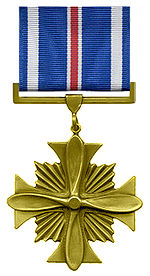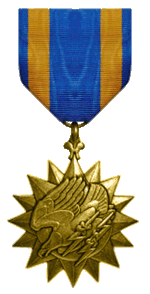Distinguished Flying Cross (United States)
| Distinguished Flying Cross | |
|---|---|
 | |
| Type | Military Decoration |
| Awarded for | "Heroism or extraordinary achievement while participating in an aerial flight" |
| Presented by | |
| Status | Currently awarded |
| Established | 2 July 1926[5] |
| First awarded | 2 May 1927 |
Service ribbon | |
| Precedence | |
| Next (higher) | Legion of Merit[6] |
| Next (lower) |
|
The Distinguished Flying Cross (DFC) is a military decoration of the United States Armed Forces. The medal was established on July 2, 1926, and is currently awarded to any persons who, after April 6, 1917, distinguish themselves by single acts of heroism or extraordinary achievement while participating in aerial flight. Both heroism and extraordinary achievement are entirely distinctive, involving operations that are not routine.[6][7] The medal may be awarded to friendly foreign military members in ranks equivalent to U.S. Pay Grade of O-6 and below, in combat in support operations.
Air Medal
| Air Medal | |
|---|---|
 | |
| Type | Military medal (Decoration) |
| Awarded for | Heroic or meritorious achievement while participating in aerial flight |
| Presented by | United States Department of the Army[1] United States Department of the Navy[2] United States Department of the Air Force[3] United States Department of Homeland Security[4] |
| Status | Currently awarded |
| Established | Executive Order 9158, May 11, 1942 (as amended by E.O. 9242-A, September 11, 1942) |
 Service ribbon (above); reverse of medal (below) | |
| Precedence | |
| Next (higher) | Meritorious Service Medal |
| Next (lower) | Army, Naval Service, and Coast Guard: Joint Service Commendation Medal Air and Space Forces: Aerial Achievement Medal |
The Air Medal (AM) is a military decoration of the United States Armed Forces. It was created in 1942 and is awarded for single acts of heroism or meritorious achievement while participating in aerial flight.[5]
Criteria[edit]
The Air Medal was established by Executive Order 9158, signed by Franklin D. Roosevelt on May 11, 1942. It was awarded retroactive to September 8, 1939, to anyone who distinguishes himself by meritorious achievement while serving with the Armed Forces in aerial flight.[5][6][7]
The original award criteria set by an Army Policy Letter dated September 25, 1942, were for one award of the Air Medal:[8]
- per each naval vessel or three enemy aircraft in flight confirmed destroyed. An entire aircrew would be credited for the destruction of a ship, but only the pilot or gunner responsible would be credited for destroying an enemy aircraft.
- per 25 operational flights during which exposure to enemy fire is expected.
- per 100 operational flights during which exposure to enemy fire is not expected.
These criteria were altered by the commanding generals of each numbered Air Force to fit the conditions of their theater of operations and to maintain morale. The Distinguished Flying Cross would usually be awarded for roughly twice to five times the requirements of the Air Medal. This led to automatic "score card" awards of the Air Medal and Distinguished Flying Cross for completing a set number of operational missions rather than distinguished service, meritorious action, or bravery, as had been intended. On August 5, 1943, such score card awards were officially abolished by a Headquarters Army Air Forces Awards Board memorandum due to the embarrassment when airmen received the Air Medal for "score carding" five missions or more but were later removed from flying duties for "lack of moral fibre". Commanders could still issue the awards on those grounds, but the recipient must perform exceptional or meritorious service as well.
Army Air Forces (1942–1947)[edit]
During World War II, the medal's award criteria varied widely depending on the theater of operations, the aircraft flown, and the missions accomplished. In Europe, the airspace was considered completely controlled by the enemy and heavy air defenses were encountered, so the criteria were altered from those of the original medal. Bomber, photographic reconnaissance, or observation crewmembers and air transport pilots received it for five sorties, fighter pilots received it for ten sorties, and individual pilots or air crewmen received one award per enemy aircraft shot down. Elsewhere in the Pacific and the China Burma India Theater, the pilots and crews flew mostly over uncontrolled or contested airspace for long hours and lighter air defenses were encountered, so much higher criteria were used. Anti-submarine patrols from the United States could qualify for the medal if an airman logged 200 hours of flight time